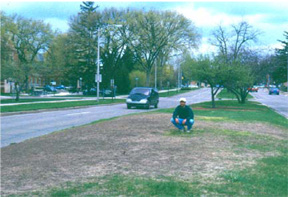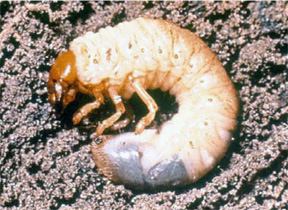How to get effective grub control in your home lawn - update 2009
Editor’s note: This article is from the archives of the MSU Crop Advisory Team Alerts. Check the label of any pesticide referenced to ensure your use is included.
It's that time of year again. Lawns are starting to green up nicely, especially with the occasional rains. But I have noticed patches in some lawns that are not turning green. Sometimes I will see a flock of birds working around the dead patches. These patches in non-irrigated lawns may be due to grubs. Before doing anything to control grubs or even to re-seed an area that is not starting to turn green, it is important to make sure that the problem is indeed grubs. If you see a dead patch, dig up a few shovelfuls of soil at the edge of the bare spot and look for one-inch long, c-shaped grubs. These are more than likely the larvae of European chafer if they are found in non-irrigated turfgrass.
European chafer can devastate a lawn with little warning because the adult beetles are not visible to the average person. They do not become active until sunset during late June and early July and can easily be missed as they move out of the soil and congregate in trees. Since they move back into the grass and lay eggs about 11:00 PM, the average person would never notice them unless they were carefully looking for them as the sun sets. European chafer grubs can now be found in all locations in the Lower Peninsula of Michigan.
Japanese beetle grubs also feed on turf, but they are not as much a problem as European chafer on home lawns. Japanese beetles like to lay their eggs on irrigated turf like golf courses and athletic fields. They will live in home lawns but rarely cause damage because they avoid dry soils.
It is important to realize that healthy turf, especially if there is plenty of rain in the spring and fall can support a grub population of five grubs per square foot with no obvious turf damage. A lawn should be mowed at 3.5-4.0 inches in height and properly fertilized to maximize root growth. But if the grub population is high, or if there is a history of damage in an area, it may be necessary to consider using chemicals for grub control.
Shopping for grub control products
I went to several of the local lawn and garden centers in the Lansing area to see what kinds of products are available that specifically claim they will work to control grubs. The number of grub-control products ranged from five to nine different products depending on which store I checked. The profusion of different products can be rather mystifying.
I found three types of products that indicated on the bag that they would control grubs: preventive products, curative products and the occasional product that the manufacturers would like to think might control grubs (but won’t).
Curative compounds should be applied when the grubs are present and active. Approaching grub control from the curative standpoint avoids unnecessary applications of chemical, but is not as effective as preventive products. Preventive compounds must be applied at the time of egg hatching or when grubs are small to be effective.
The first critical issue is to determine what active ingredient the product contains by looking at the label. Look on the bag at the lower right or left corner to determine what and how much active ingredient is in the product.
Do not use products containing only lambda-cyhalothrin, gamma-cyhalothrin, bifenthrin, deltamethrin, cyfluthrin and permethrin for grub control. Products containing these ingredients will not work for grub control. When applied to the soil surface as the active compound, they will bind with organic material and will not move down to where the grubs are feeding. These products work well for above-ground feeding insects that live on the grass leaves or soil surface, but not for insects that feed on the roots.
There are a few combination products that include one of the above mentioned chemicals and imidacloprid. These products will work because they include imidacloprid. One product containing an active ingredient that will only control surface insects had a note on the label indicating another product with a different active ingredient should be used for grub control (the other product contained an appropriate active ingredient that would work well on grubs). But I found one product that said it would control grubs that contained only gamma-cyhalothrin. We tested this product in 2006 and it worked as well as doing nothing at all.
Products containing imidacloprid or halofenozide will not control grubs in the spring. They are preventive products and do not work well for large grubs. Although the bag often says apply anytime from May to August 15, it is highly recommended that these products be applied and irrigated into the soil during June or July. If applied now, they will have little or no effect on the grubs currently in the lawn. I specifically saw Scotts Grub-Ex, Bayer Advanced Season Long Grub Control with Merit, Bayer Advanced Complete Insect Killer (which contains both imidacloprid and cyfluthrin), a product called Grub and Lawn Insect Control and Spectracide One Stop Once and Done, that contained one of these active ingredients currently in stores. If applied in June or July and watered into the ground, these products will give 90-100 percent grub control. They will cost $140 to $250 to treat an acre of turf. An average-sized lawn is about a quarter acre.
What to use now
Any product that contains carbaryl (Sevin) or trichlorfon (Dylox) will work well when applied in the spring (from March to mid-May) or in the fall (September 1 to November 1). These are considered curative compounds as opposed to the preventive compounds mentioned above and will kill the grubs currently in the ground. It is necessary to irrigate after applying any curative product to get the chemical to the grubs. Run a lawn sprinkler for at least 60 minutes over treated areas (fill a bucket to a half-inch). It will take 10 to 14 days for the grubs to begin to die. One trichlorfon product called Bayer Advanced 24 Hour Grub Control seems to indicate by the name that it will kill grubs in 24 hours. However, I doubt that any of the insecticides will kill grubs in the soil in much less than five days unless there is a very heavy rain and very warm temperatures the day of application.
Do not apply any curative compound after May 15 as the grubs stop feeding in late May. These “curative” compounds will typically give 65 to 85 percent control of grubs and will cost $150 to $303 to treat an acre. If grubs are present in a lawn in high numbers, it is advisable to wait for a week after applying a chemical control before reseeding.

Grub damage on turfgrass.

Grubs as they would appear in the spring.
In summary
- Check the bag to determine what active ingredient the product contains.
- Do not use products containing only lambda-cyhalothin, gamma-cyhalothrin, bifenthrin, deltamethrin, cyfluthrin or permethrin for any phase of grub control.
- Do not use preventive compounds such as halfenozide or imidacloprid now. Use them in June or July to control grubs that would be damaging turf in the fall.
- To kill grubs in the spring (or fall) use carbaryl or trichlorfon and irrigate.
- Always wear rubber gloves and rubber boots when applying insecticides to turfgrass. Irrigate the lawn with at least a half inch of water and allow the grass to dry before allowing anyone (or pets) into the treated area.
The following is a short list of products now being sold for grub control as of April 13 in the mid-Michigan area. The number of asterisks (*) after the brand name indicates how many locations out of the three garden centers I checked were selling the particular product.
|
Sevin-Lawn Insect Granules (20 lb bag) *Garden Tech carbaryl 2.0% 9 lb/1000 ft2 Apply in spring or fall to active grubs. |
|
24 hr Grub Killer Plus (15 lb bag) *** Made by Bayer Advanced trichlorfon 6.2% 3 lbs/1000 ft2 Apply in spring or fall to active grubs. |
|
Complete Insect Killer (10 lb bag) * Made by Bayer Advanced cyfluthrin 0.05% and imidacloprid 0.15% 3 lbs/1000 ft2 |
|
GrubEx (14.35 lb bag) *** Made by Scotts imidacloprid 0.2% 2.87 lb/1000 ft2 |
|
Grub Beater *Made by BonideImidacloprid 0.2%1.8 lb/1000 ft2Apply in early July. |
|
Spectracide Grub Stop Once and Done + fertilizer *Imidacloprid 0.22%3.8 lb/1000 ft2Apply in early July. |
|
Season Long Grub Control (14.35 lb bag) *** Made by Bayer Advanced imidacloprid 0.25% 2.4 lb/1000 ft2 |
|
Grub & Lawn Insect Control (15 lb bag) * labeled by the local retail distributor halofenozide 1.5% 3 lbs/1000 ft2 Apply in early July. |
|
Triazicide Insect Killer Once and Done Granules ** (10 lb bag) Made by Spectracide gamma cyhalothrin 0.05% |



 Print
Print Email
Email

